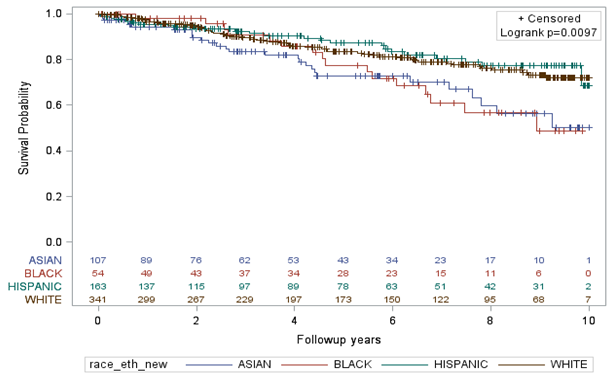Session Information
Date: Tuesday, October 23, 2018
Title: Systemic Sclerosis and Related Disorders – Clinical Poster III
Session Type: ACR Poster Session C
Session Time: 9:00AM-11:00AM
Background/Purpose: Studies indicate that black patients with systemic sclerosis (SSc) demonstrate a distinct phenotypic profile, with more severe disease, heightened mortality, and poorer prognosis compared to whites. Limited studies have evaluated disease severity and mortality in Asian Americans. Our aim was to compare disease manifestations and survival across race/ethnicity in SSc patients from Northern California, with a focus on Asians.
Methods: A retrospective study was conducted among Kaiser Permanente Northern California adults with a diagnosis of SSc by a rheumatologist from 2007-2017, confirmed by chart review to fulfill 2013 ACR-EULAR classification criteria. Self-reported race/ethnicity was categorized as: white, Asian, Hispanic, and black. Other racial subgroups were excluded from this study. Disease manifestations and all-cause mortality were compared between the race/ethnic groups with whites as the reference. Chi-square, Fisher exact tests, and multest were used for categorical variables. Kaplan-Meier and multivariate Cox regression analyses were used to estimate the probability of survival by race/ethnicity for incident cases, and to assess if race/ethnicity was a significant factor associated with death correcting for age. P<0.05 was considered statistically significant.
Results: 1055 SSc patients were included with 665 incident and 390 prevalent cases. Most patients had limited cutaneous SSc (n=937, 89%) with only 11% categorized as diffuse (n=118). 89% were female, with mean age 56.5±14.6 years, and mean disease duration 5.0±3.2 years from date of diagnosis. The racial/ethnic distribution was 54% white (n=569), 23% Hispanic (n=241), 14% Asian (n=152), and 9% black (n=93). Although Hispanics did not display any significant differences in clinical features from whites, Asians had a lower frequency of calcinosis (32% vs. 16%, p<0.001) and telangiectasias (75% vs. 53%, p<0.001); blacks had a higher frequency of interstitial lung disease (38% vs. 57%, p=0.016), but a lower frequency of telangiectasias (75% vs. 53%, p<0.001) and Raynaud phenomenon (98% vs. 91%, p=0.036). 9-year overall survival rates for whites, Hispanics, Asians, and blacks were 72.0%, 68.6%, 50.1%, and 48.6%, respectively (log-rank p<0.01)(Figure 1). Pairwise comparisons demonstrated increased mortality in Asians compared to non-Asians (p=0.008). On multivariate analysis, Asians and blacks had increased mortality compared to whites even after controlling for age (HR 2.2, CI 1.4-3.5, p<0.001; HR 2.3, CI 1.3-4.0, p<0.001, respectively), but not Hispanics (HR 1.1, CI 0.7-1.8, p=0.6).
Conclusion: Survival in patients with SSc from Northern California differs by race. Asians and blacks had more than 2-fold increased risk of death compared with whites.
Table 1: Kaplan-Meier survival estimate by race/ethnicity
To cite this abstract in AMA style:
Chung M, Dontsi M, Postlethwaite D, Kesh S, Zaba L, Chung L. Increased Mortality in Black and Asian Patients with Systemic Sclerosis in Northern California [abstract]. Arthritis Rheumatol. 2018; 70 (suppl 9). https://acrabstracts.org/abstract/increased-mortality-in-black-and-asian-patients-with-systemic-sclerosis-in-northern-california/. Accessed .« Back to 2018 ACR/ARHP Annual Meeting
ACR Meeting Abstracts - https://acrabstracts.org/abstract/increased-mortality-in-black-and-asian-patients-with-systemic-sclerosis-in-northern-california/

